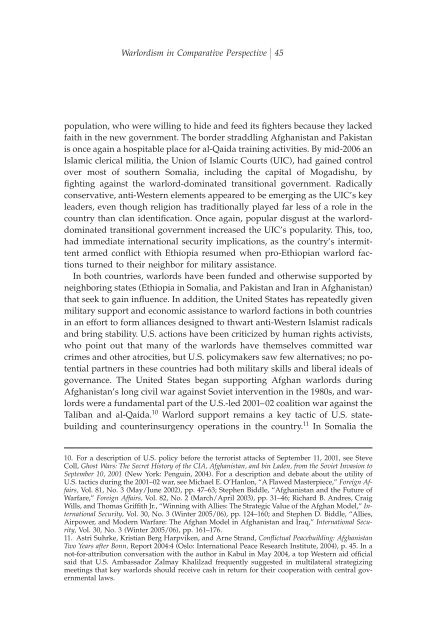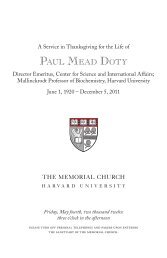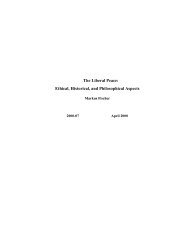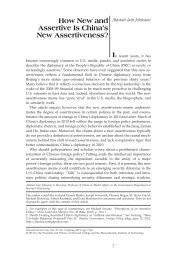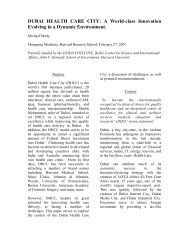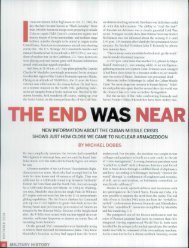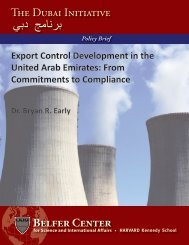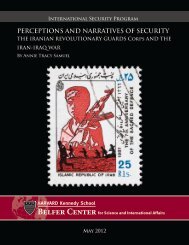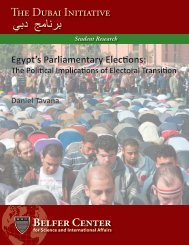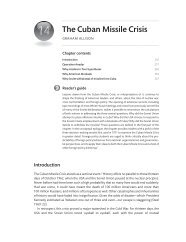Warlordism in Comparative Perspective - MIT Press Journals
Warlordism in Comparative Perspective - MIT Press Journals
Warlordism in Comparative Perspective - MIT Press Journals
You also want an ePaper? Increase the reach of your titles
YUMPU automatically turns print PDFs into web optimized ePapers that Google loves.
<strong>Warlordism</strong> <strong>in</strong> <strong>Comparative</strong> <strong>Perspective</strong> 45<br />
population, who were will<strong>in</strong>g to hide and feed its ªghters because they lacked<br />
faith <strong>in</strong> the new government. The border straddl<strong>in</strong>g Afghanistan and Pakistan<br />
is once aga<strong>in</strong> a hospitable place for al-Qaida tra<strong>in</strong><strong>in</strong>g activities. By mid-2006 an<br />
Islamic clerical militia, the Union of Islamic Courts (UIC), had ga<strong>in</strong>ed control<br />
over most of southern Somalia, <strong>in</strong>clud<strong>in</strong>g the capital of Mogadishu, by<br />
ªght<strong>in</strong>g aga<strong>in</strong>st the warlord-dom<strong>in</strong>ated transitional government. Radically<br />
conservative, anti-Western elements appeared to be emerg<strong>in</strong>g as the UIC’s key<br />
leaders, even though religion has traditionally played far less of a role <strong>in</strong> the<br />
country than clan identiªcation. Once aga<strong>in</strong>, popular disgust at the warlorddom<strong>in</strong>ated<br />
transitional government <strong>in</strong>creased the UIC’s popularity. This, too,<br />
had immediate <strong>in</strong>ternational security implications, as the country’s <strong>in</strong>termittent<br />
armed conºict with Ethiopia resumed when pro-Ethiopian warlord factions<br />
turned to their neighbor for military assistance.<br />
In both countries, warlords have been funded and otherwise supported by<br />
neighbor<strong>in</strong>g states (Ethiopia <strong>in</strong> Somalia, and Pakistan and Iran <strong>in</strong> Afghanistan)<br />
that seek to ga<strong>in</strong> <strong>in</strong>ºuence. In addition, the United States has repeatedly given<br />
military support and economic assistance to warlord factions <strong>in</strong> both countries<br />
<strong>in</strong> an effort to form alliances designed to thwart anti-Western Islamist radicals<br />
and br<strong>in</strong>g stability. U.S. actions have been criticized by human rights activists,<br />
who po<strong>in</strong>t out that many of the warlords have themselves committed war<br />
crimes and other atrocities, but U.S. policymakers saw few alternatives; no potential<br />
partners <strong>in</strong> these countries had both military skills and liberal ideals of<br />
governance. The United States began support<strong>in</strong>g Afghan warlords dur<strong>in</strong>g<br />
Afghanistan’s long civil war aga<strong>in</strong>st Soviet <strong>in</strong>tervention <strong>in</strong> the 1980s, and warlords<br />
were a fundamental part of the U.S.-led 2001–02 coalition war aga<strong>in</strong>st the<br />
Taliban and al-Qaida. 10 Warlord support rema<strong>in</strong>s a key tactic of U.S. statebuild<strong>in</strong>g<br />
and counter<strong>in</strong>surgency operations <strong>in</strong> the country. 11 In Somalia the<br />
10. For a description of U.S. policy before the terrorist attacks of September 11, 2001, see Steve<br />
Coll, Ghost Wars: The Secret History of the CIA, Afghanistan, and b<strong>in</strong> Laden, from the Soviet Invasion to<br />
September 10, 2001 (New York: Pengu<strong>in</strong>, 2004). For a description and debate about the utility of<br />
U.S. tactics dur<strong>in</strong>g the 2001–02 war, see Michael E. O’Hanlon, “A Flawed Masterpiece,” Foreign Affairs,<br />
Vol. 81, No. 3 (May/June 2002), pp. 47–63; Stephen Biddle, “Afghanistan and the Future of<br />
Warfare,” Foreign Affairs, Vol. 82, No. 2 (March/April 2003), pp. 31–46; Richard B. Andres, Craig<br />
Wills, and Thomas Grifªth Jr., “W<strong>in</strong>n<strong>in</strong>g with Allies: The Strategic Value of the Afghan Model,” International<br />
Security, Vol. 30, No. 3 (W<strong>in</strong>ter 2005/06), pp. 124–160; and Stephen D. Biddle, “Allies,<br />
Airpower, and Modern Warfare: The Afghan Model <strong>in</strong> Afghanistan and Iraq,” International Security,<br />
Vol. 30, No. 3 (W<strong>in</strong>ter 2005/06), pp. 161–176.<br />
11. Astri Suhrke, Kristian Berg Harpviken, and Arne Strand, Conºictual Peacebuild<strong>in</strong>g: Afghanistan<br />
Two Years after Bonn, Report 2004:4 (Oslo: International Peace Research Institute, 2004), p. 45. In a<br />
not-for-attribution conversation with the author <strong>in</strong> Kabul <strong>in</strong> May 2004, a top Western aid ofªcial<br />
said that U.S. Ambassador Zalmay Khalilzad frequently suggested <strong>in</strong> multilateral strategiz<strong>in</strong>g<br />
meet<strong>in</strong>gs that key warlords should receive cash <strong>in</strong> return for their cooperation with central governmental<br />
laws.


